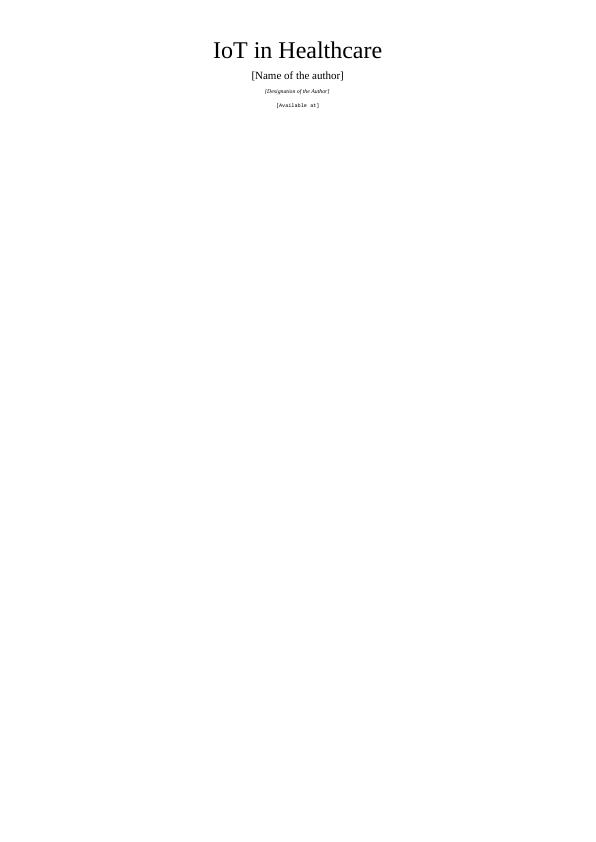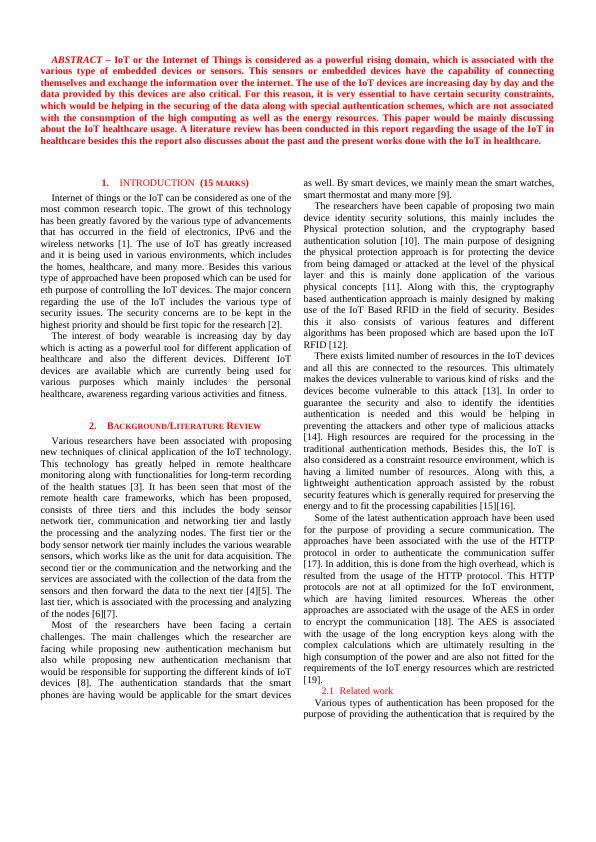The internet of things in healthcare: An overview
Added on 2021-06-16
5 Pages4243 Words31 Views
IoT in Healthcare[Name of the author][Designation of the Author][Available at]

ABSTRACT – IoT or the Internet of Things is considered as a powerful rising domain, which is associated with thevarious type of embedded devices or sensors. This sensors or embedded devices have the capability of connectingthemselves and exchange the information over the internet. The use of the IoT devices are increasing day by day and thedata provided by this devices are also critical. For this reason, it is very essential to have certain security constraints,which would be helping in the securing of the data along with special authentication schemes, which are not associatedwith the consumption of the high computing as well as the energy resources. This paper would be mainly discussingabout the IoT healthcare usage. A literature review has been conducted in this report regarding the usage of the IoT inhealthcare besides this the report also discusses about the past and the present works done with the IoT in healthcare.1.INTRODUCTION (15 MARKS)Internet of things or the IoT can be considered as one of themost common research topic. The growt of this technologyhas been greatly favored by the various type of advancementsthat has occurred in the field of electronics, IPv6 and thewireless networks [1]. The use of IoT has greatly increasedand it is being used in various environments, which includesthe homes, healthcare, and many more. Besides this varioustype of approached have been proposed which can be used foreth purpose of controlling the IoT devices. The major concernregarding the use of the IoT includes the various type ofsecurity issues. The security concerns are to be kept in thehighest priority and should be first topic for the research [2].The interest of body wearable is increasing day by daywhich is acting as a powerful tool for different application ofhealthcare and also the different devices. Different IoTdevices are available which are currently being used forvarious purposes which mainly includes the personalhealthcare, awareness regarding various activities and fitness. 2.BACKGROUND/LITERATURE REVIEWVarious researchers have been associated with proposingnew techniques of clinical application of the IoT technology.This technology has greatly helped in remote healthcaremonitoring along with functionalities for long-term recordingof the health statues [3]. It has been seen that most of theremote health care frameworks, which has been proposed,consists of three tiers and this includes the body sensornetwork tier, communication and networking tier and lastlythe processing and the analyzing nodes. The first tier or thebody sensor network tier mainly includes the various wearablesensors, which works like as the unit for data acquisition. Thesecond tier or the communication and the networking and theservices are associated with the collection of the data from thesensors and then forward the data to the next tier [4][5]. Thelast tier, which is associated with the processing and analyzingof the nodes [6][7]. Most of the researchers have been facing a certainchallenges. The main challenges which the researcher arefacing while proposing new authentication mechanism butalso while proposing new authentication mechanism thatwould be responsible for supporting the different kinds of IoTdevices [8]. The authentication standards that the smartphones are having would be applicable for the smart devicesas well. By smart devices, we mainly mean the smart watches,smart thermostat and many more [9].The researchers have been capable of proposing two maindevice identity security solutions, this mainly includes thePhysical protection solution, and the cryptography basedauthentication solution [10]. The main purpose of designingthe physical protection approach is for protecting the devicefrom being damaged or attacked at the level of the physicallayer and this is mainly done application of the variousphysical concepts [11]. Along with this, the cryptographybased authentication approach is mainly designed by makinguse of the IoT Based RFID in the field of security. Besidesthis it also consists of various features and differentalgorithms has been proposed which are based upon the IoTRFID [12].There exists limited number of resources in the IoT devicesand all this are connected to the resources. This ultimatelymakes the devices vulnerable to various kind of risks and thedevices become vulnerable to this attack [13]. In order toguarantee the security and also to identify the identitiesauthentication is needed and this would be helping inpreventing the attackers and other type of malicious attacks[14]. High resources are required for the processing in thetraditional authentication methods. Besides this, the IoT isalso considered as a constraint resource environment, which ishaving a limited number of resources. Along with this, alightweight authentication approach assisted by the robustsecurity features which is generally required for preserving theenergy and to fit the processing capabilities [15][16]. Some of the latest authentication approach have been usedfor the purpose of providing a secure communication. Theapproaches have been associated with the use of the HTTPprotocol in order to authenticate the communication suffer[17]. In addition, this is done from the high overhead, which isresulted from the usage of the HTTP protocol. This HTTPprotocols are not at all optimized for the IoT environment,which are having limited resources. Whereas the otherapproaches are associated with the usage of the AES in orderto encrypt the communication [18]. The AES is associatedwith the usage of the long encryption keys along with thecomplex calculations which are ultimately resulting in thehigh consumption of the power and are also not fitted for therequirements of the IoT energy resources which are restricted[19].2.1Related workVarious types of authentication has been proposed for thepurpose of providing the authentication that is required by the

End of preview
Want to access all the pages? Upload your documents or become a member.
Related Documents
IoT in Healthcare Assignment PDFlg...
|7
|7185
|137
Technological innovation | Conceptslg...
|13
|3100
|44
IoT in Healthcare: Advantages, Challenges, and Current Methodologieslg...
|9
|7876
|124
IoT in Healthcare: Securing Data and Enhancing Authentication for Wearable Deviceslg...
|29
|9374
|104
IoT in Healthcare Industry - Literature Review and Annotated Bibliographylg...
|7
|1755
|212
Information Security Assignment : iot security research paperslg...
|11
|2361
|349
